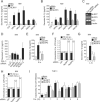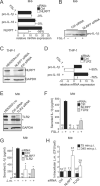An NLRP7-containing inflammasome mediates recognition of microbial lipopeptides in human macrophages
- PMID: 22361007
- PMCID: PMC3315380
- DOI: 10.1016/j.immuni.2012.02.001
An NLRP7-containing inflammasome mediates recognition of microbial lipopeptides in human macrophages
Abstract
Cytosolic pathogen- and damage-associated molecular patterns are sensed by pattern recognition receptors, including members of the nucleotide-binding domain and leucine-rich repeat-containing gene family (NLR), which cause inflammasome assembly and caspase-1 activation to promote maturation and release of the inflammatory cytokines interleukin-1β (IL-1β) and IL-18 and induction of pyroptosis. However, the contribution of most of the NLRs to innate immunity, host defense, and inflammasome activation and their specific agonists are still unknown. Here we describe identification and characterization of an NLRP7 inflammasome in human macrophages, which is induced in response to microbial acylated lipopeptides. Activation of NLRP7 promoted ASC-dependent caspase-1 activation, IL-1β and IL-18 maturation, and restriction of intracellular bacterial replication, but not caspase-1-independent secretion of the proinflammatory cytokines IL-6 and tumor necrosis factor-α. Our study therefore increases our currently limited understanding of NLR activation, inflammasome assembly, and maturation of IL-1β and IL-18 in human macrophages.
Copyright © 2012 Elsevier Inc. All rights reserved.
Figures







Comment in
-
Innate immunity: Linking mitochondria and microbes to inflammasomes.Nat Rev Immunol. 2012 Mar 9;12(4):229. doi: 10.1038/nri3195. Nat Rev Immunol. 2012. PMID: 22402669 No abstract available.
Similar articles
-
Activation of NLRP3 inflammasome in macrophages by mycoplasmal lipoproteins and lipopeptides.Mol Oral Microbiol. 2018 Aug;33(4):300-311. doi: 10.1111/omi.12225. Epub 2018 May 29. Mol Oral Microbiol. 2018. PMID: 29682880
-
Inflammasomes: guardians of cytosolic sanctity.Immunol Rev. 2009 Jan;227(1):95-105. doi: 10.1111/j.1600-065X.2008.00730.x. Immunol Rev. 2009. PMID: 19120479 Review.
-
Virulent Mycobacterium bovis Beijing Strain Activates the NLRP7 Inflammasome in THP-1 Macrophages.PLoS One. 2016 Apr 4;11(4):e0152853. doi: 10.1371/journal.pone.0152853. eCollection 2016. PLoS One. 2016. PMID: 27043315 Free PMC article.
-
ATP binding by NLRP7 is required for inflammasome activation in response to bacterial lipopeptides.Mol Immunol. 2015 Oct;67(2 Pt B):294-302. doi: 10.1016/j.molimm.2015.06.013. Epub 2015 Jul 2. Mol Immunol. 2015. PMID: 26143398 Free PMC article.
-
The inflammasome: a caspase-1-activation platform that regulates immune responses and disease pathogenesis.Nat Immunol. 2009 Mar;10(3):241-7. doi: 10.1038/ni.1703. Nat Immunol. 2009. PMID: 19221555 Free PMC article. Review.
Cited by
-
The Human-Specific STING Agonist G10 Activates Type I Interferon and the NLRP3 Inflammasome in Porcine Cells.Front Immunol. 2020 Sep 24;11:575818. doi: 10.3389/fimmu.2020.575818. eCollection 2020. Front Immunol. 2020. PMID: 33072119 Free PMC article.
-
NLRP6 in infection and inflammation.Microbes Infect. 2013 Sep-Oct;15(10-11):661-8. doi: 10.1016/j.micinf.2013.06.009. Epub 2013 Jun 28. Microbes Infect. 2013. PMID: 23811097 Free PMC article. Review.
-
Platelet-activating factor (PAF) mediates NLRP3-NEK7 inflammasome induction independently of PAFR.J Exp Med. 2019 Dec 2;216(12):2838-2853. doi: 10.1084/jem.20190111. Epub 2019 Sep 26. J Exp Med. 2019. PMID: 31558613 Free PMC article.
-
In Vitro Anti-Inflammatory Effects of Phenolic Compounds from Moraiolo Virgin Olive Oil (MVOO) in Brain Cells via Regulating the TLR4/NLRP3 Axis.Molecules. 2019 Dec 10;24(24):4523. doi: 10.3390/molecules24244523. Molecules. 2019. PMID: 31835609 Free PMC article.
-
A promiscuous inflammasome sparks replication of a common tumor virus.Proc Natl Acad Sci U S A. 2020 Jan 21;117(3):1722-1730. doi: 10.1073/pnas.1919133117. Epub 2020 Jan 9. Proc Natl Acad Sci U S A. 2020. PMID: 31919284 Free PMC article.
References
-
- Alexopoulou L, Thomas V, Schnare M, Lobet Y, Anguita J, Schoen RT, Medzhitov R, Fikrig E, Flavell RA. Hyporesponsiveness to vaccination with Borrelia burgdorferi OspA in humans and in TLR1- and TLR2-deficient mice. Nat Med. 2002;8:878–884. - PubMed
-
- Aliprantis AO, Yang RB, Mark MR, Suggett S, Devaux B, Radolf JD, Klimpel GR, Godowski P, Zychlinsky A. Cell activation and apoptosis by bacterial lipoproteins through toll-like receptor-2. Science. 1999;285:736–739. - PubMed
-
- Boyden ED, Dietrich WF. Nalp1b controls mouse macrophage susceptibility to anthrax lethal toxin. Nat Genet. 2006;38:240–244. - PubMed
Publication types
MeSH terms
Substances
Grants and funding
LinkOut - more resources
Full Text Sources
Other Literature Sources
Research Materials
Miscellaneous

